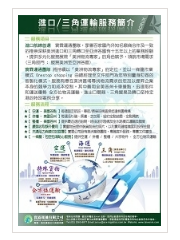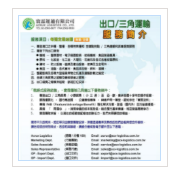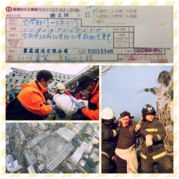美西工人談判開始,碼頭持續擁塞
目前由於LA壅塞的情形是越來越嚴重,碼頭作業緩慢,
導致卡車在LA等托盤都要等平均2~3個小時,也有領不到托盤的可能
最主要的原因是碼頭工人在雇主談判中還未得到他們所希望的合約保障,現在談判還持續中,
如果談判破裂西岸可能又會發起罷工,這將會影響從美國西岸出口的船期,
目前影響時間還未知,估計可能會影響到年底,請向客戶留意。
以下為英文新聞稿:
******************************************

Congestion at the ports of Los Angeles and Long Beach grew worse over the weekend, with no relief in sight as late peak-season container volumes descend on the largest U.S. port complex.
“The vessels keep arriving and the trucks keep arriving,” said John Cushing, president of PierPass Inc., which manages the extended gates program for the 13 container terminals in the port complex.
Cushing said terminal operators are spending millions of dollars and taking extraordinary steps, including running very costly “hoot owl” shifts from 3 a.m. to 8 a.m. to relieve congestion in their container yards. But the cargo keeps building up at the terminals. According to the individual ports, combined container throughput in 2014 through August at the Ports of Los Angeles and Long Beach are 4.5 percent higher than the same period in 2013.
Each terminal operator has a slightly different story to tell. Some terminals say the congestion ebbs and flows depending upon chassis availability. A terminal will get enough chassis for several consecutive days to clean out its yard, but then the equipment supply dries up and the terminal is congested again.
“There are times when the imports are not moving. The numbers are outrageous —6,000 to 7,000 containers just sitting at the terminals,” he said.
Another terminal operator said he is working only two cranes each week against a vessel with a capacity of 10,000 20-foot containers, rather than five cranes as he should be, because the yard can not absorb any more boxes. Vessel operations are slowing down to the point where some terminals are in danger of having to tell vessel operators to slow down their arrivals because the ships can not be handled on schedule.
Large North American gateways such as Los Angeles-Long Beach, New York-New Jersey and Vancouver, Canada, have been struggling with congestion problems on and off throughout the year. The ripple effect of brutal winter weather in the eastern half of the continent, congestion and rail car shortages on the rail networks, truck and driver shortages and chassis dislocations are well documented.
In Southern California, truckers and terminal operators point to chassis being in short supply, in the wrong place at the wrong time or chassis being out-of-service as being the main culprit.
“Chassis are the Achilles’ Heel here,” said Fred Johring, president of Golden State Express and chairman of the Harbor Trucking Association of Southern California.
Ocean carriers earlier this year exited the chassis business in Los Angeles-Long Beach and New York-New Jersey, selling the assets to chassis leasing companies. Terminals on both coasts immediately began to report that they did not have enough chassis, not because the overall supplies in the harbors were reduced, but because the business relationships involving cargo interests, shipping lines, terminal operators and chassis providers had changed.
Suddenly, truckers were told by a terminal that the chassis they needed were no longer being stored at the terminal, so the truckers had to make an extra trip to a location where the chassis suppliers stored the equipment. In instances where a terminal had chassis, many more chassis than usual were being “red-tagged” as being out of service and in need of repair.
Terminal operators say the chassis providers are refusing to pay the suddenly high repair costs that terminals with International Longshore and Warehouse Union labor are charging, or the chassis providers would only authorize repairs during the 8 a.m. to 5 p.m. day shift to avoid overtime pay. Chassis providers say they are authorizing repairs as quickly as they can, and have indicated to the ports that there are not enough skilled mechanics at the terminals to do the work.
As containers back up at the terminals, ILWU labor is working overtime just to do the normal work of unloading vessels, cleaning out the yards and processing trucks into and out of the facilities. According to figures posted on the website of the Pacific Maritime Association, the container volumes handled in Los Angeles-Long Beach in August were up 1 percent from August 2013, but the man-hours paid by the terminals were 20 percent higher.
Citing those numbers, PMA President Jim McKenna said, “when we’re using 20 percent more labor to do 1 percent more volume, we’re doing a lot of work.”
McKenna put the problems at the ports squarely on the shoulders of the chassis issue. “The root of all evils in the harbor is the chassis shortage,” he said.
The extra moves that longshoremen must make each day to clean up the container backlog are sucking up skilled labor, and terminals are reporting that the PMA has begun to rationalize the dispatching of positions like top handlers and rubber-tired gantry operators. Those positions can not be handled to part-time workers, known as casuals.
The extra work is also forcing terminals to use a higher percentage of casuals for driving yard tractors and other positions they can fill, but productivity normally drops when the percentage of casuals increases.
Terminal operators say a shortage of truck drivers both in the harbor area, and at the warehouses in the Inland Empire 50miles from the ports, is causing the dwell times for containers and chassis to skyrocket. Alex Cherin, executive director of the Harbor Trucking Association, said the HTA saw the driver shortage surface several years ago as a result of the clean-trucks program in Southern California. The truck and driver population of mostly owner-operators went from 15,000 to less than 10,000 as non-compliant trucks were phased out.
HTA took actions such as helping to develop a driver training program at a local community college, but the overall problem was masked by the economic recession. Now that the recession is over, the driver shortage is all too apparent, he said.
“You hear more about it on the drayage side, but it exists throughout the industry. It’s a national problem,” Cherin said.
As a result, hundreds of chassis with empty containers are sitting idle at the 1.5 billion square feet of warehouse and distribution facilities throughout Southern California, effectively taking the chassis out of use. Trucking companies say the beneficial cargo owners are so desperate to get their inbound loads that they are telling drivers not to bring the empties back to the harbor and be forced to wait two hours or longer to be processed, but rather to go “bobtail” right to the harbor as soon as the inbound containers are cleared for pickup.
Terminal operators confirm that the number of dual transactions (empty container into the terminal and loaded import container out of the terminal) have plummeted. Cushing said that PierPass is meeting with chassis providers, truckers, shipping lines and terminal operators in an attempt to work out at least a short-term solution to problem. After having met with executives of the three largest equipment providers — Direct ChassisLink Inc., Flexi-Van and Trac Intermodal — PierPass was told a long-term solution to the chassis problems will not materialize until early 2015, Cushing said.
******************************************


.gif)


.png)





.png)







.png)



(1).gif)
(1)(1).gif)
(1).jpg)



